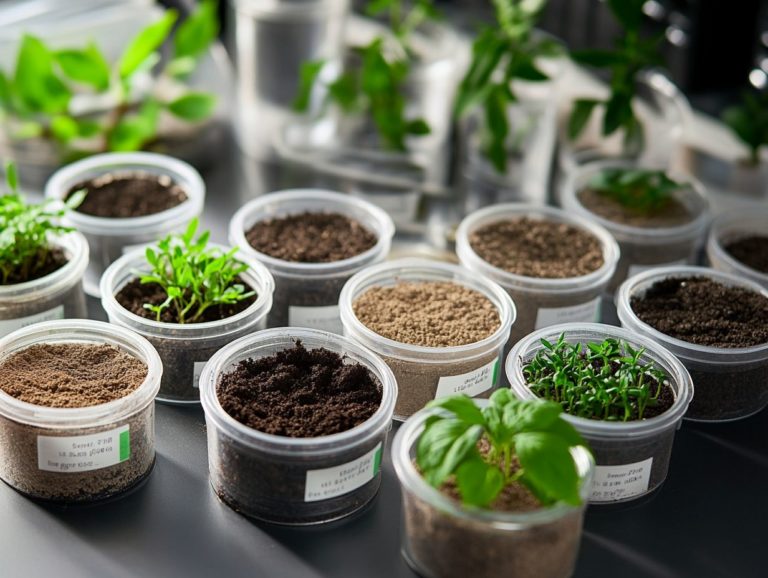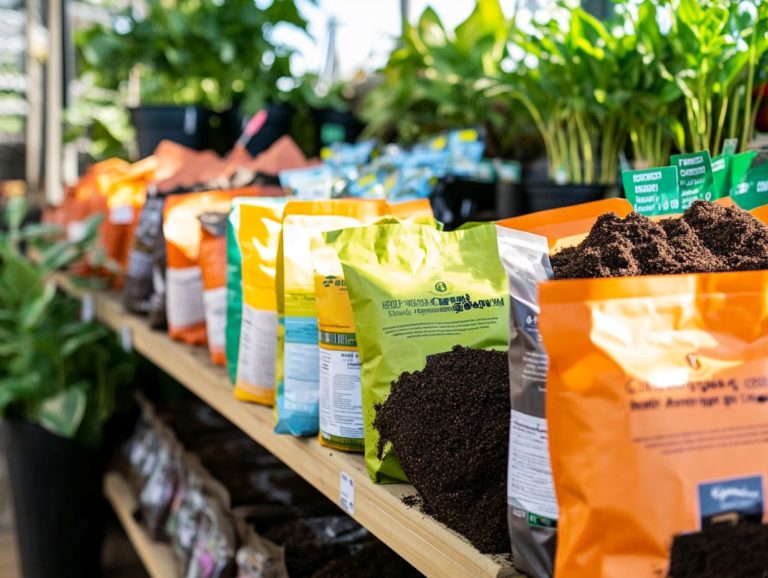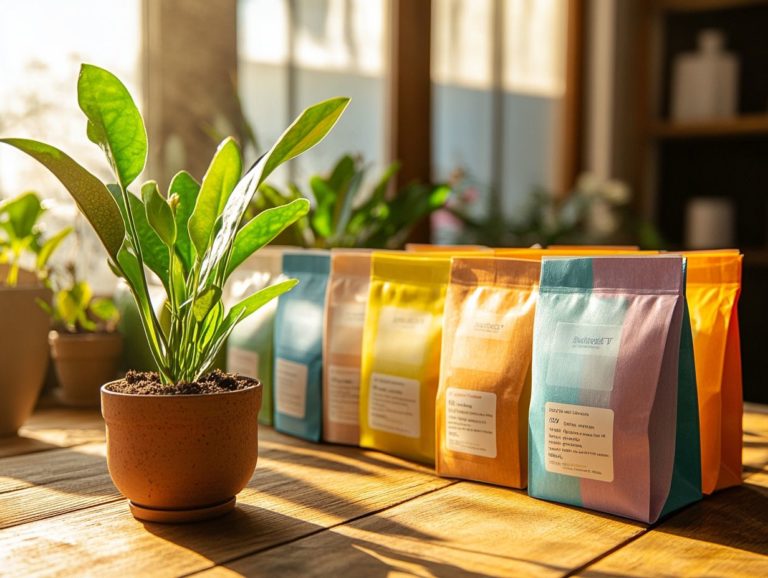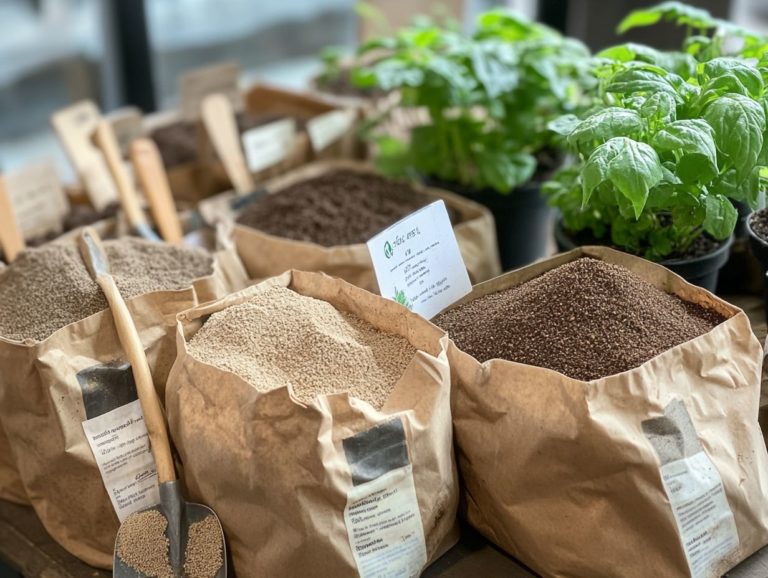How to Find the Right Soil for Your Indoor Plants
Choosing the right potting soil for your indoor plants is crucial for their health and growth. Each plant has its own unique soil requirements, and recognizing these needs can mean the difference between a thriving garden and one that barely survives.
This article delves into the essential factors you should consider when selecting soil. It compares different types and provides practical tips for testing and maintaining soil quality, including watering tips and soil amendments. It also points out common mistakes to avoid, ensuring that your indoor plants not only survive but thrive for years to come.
Contents
- Key Takeaways:
- Understanding Indoor Plant Soil Needs
- Types of Indoor Plant Soil
- Choosing the Right Soil for Your Plant
- How to Test Soil Quality
- Maintaining Healthy Soil for Indoor Plants
- Common Mistakes to Avoid with Indoor Plant Soil
- Frequently Asked Questions
- What should I look for when trying to find the right soil for my indoor plants?
- Can I use regular garden soil for my indoor plants?
- What type of soil mix is best for succulents and cacti?
- How can I tell if my indoor plants need to be repotted with new soil?
- Are there any alternative soil options for my indoor plants?
- Is it necessary to add fertilizer to my indoor plant’s soil?
Key Takeaways:
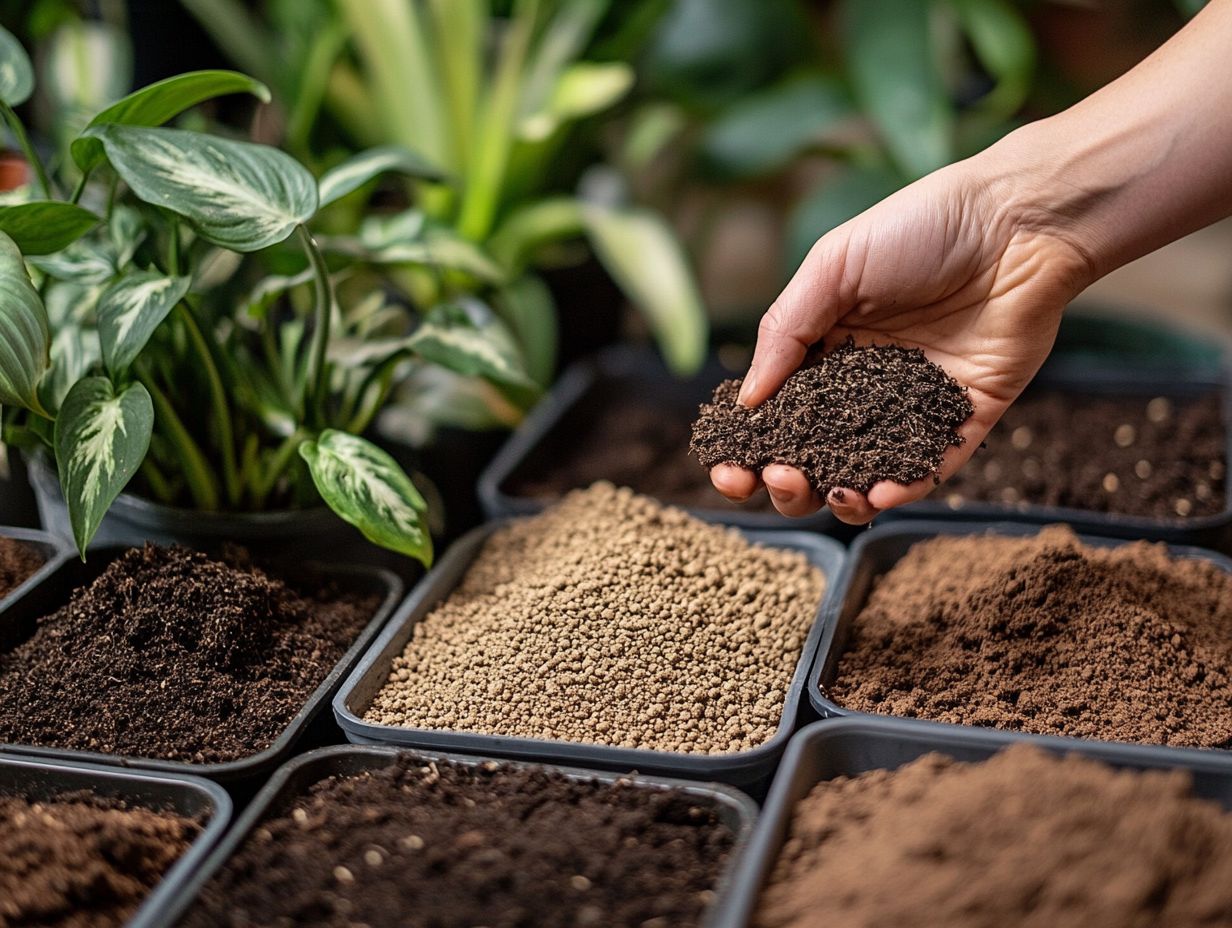
- Match the soil mix to your plant’s needs by considering factors like air circulation, drainage, nutrients, and soil pH level.
- Test the quality of your indoor plant soil regularly using methods like conducting a finger test or using a soil testing kit.
- Maintain healthy soil for your indoor plants by providing proper nourishment and protection. Avoid common mistakes like overwatering or using low-quality potting mix.
Understanding Indoor Plant Soil Needs
Understanding the specific soil needs of your indoor plants is essential for cultivating their health and vibrancy through proper plant care. The right potting soil does more than just provide air circulation and drainage; it also ensures an ideal soil composition that supports moisture retention and nutrient release.
You’ll want to consider various factors, including the type of plant, your container gardening setup, and your overall plant care routine. By paying close attention to these soil requirements, such as what to know about soil for houseplants, you can significantly boost the health of your indoor plants. This will result in thriving greenery that enriches your living space and enhances your indoor gardening experience.
Key Factors to Consider
When selecting potting soil for your indoor plants, it s essential to consider several key factors to ensure their optimal growth and health.
Soil pH plays a critical role in nutrient availability. For instance, aiming for a slightly acidic pH of around 6.0 to 6.5 is ideal for many houseplants and tropical plants, such as pothos and peace lilies, as it aligns perfectly with nutrient absorption.
Incorporate drainage holes in your containers. This simple step prevents root rot by allowing excess water to escape—an absolute must for plants like succulents and cacti that thrive in drier conditions. Additionally, learning how to use compost in indoor plant soil can further enhance their growth.
Lastly, ensuring adequate aeration within the soil not only promotes drainage but also encourages robust root growth and supports healthy roots. For example, orchids greatly benefit from well-draining mixtures specifically designed to support their unique root structures.
Types of Indoor Plant Soil
You will find a variety of indoor plant soils, including specialized mixes like cacti mix and houseplant mix. Each is meticulously crafted to cater to the unique needs of different indoor plants. This ensures that your indoor gardening endeavors are not only fruitful but also thrive in the best possible conditions.
Comparing Different Options
Comparing different options for indoor plant soil gives you the power to make informed decisions about which mix best suits your plants’ needs.
Understanding the nuances between sandy, clay, and loamy soils reveals how each type influences drainage and moisture retention, both of which are vital for your plants’ well-being. For example, succulents flourish in well-draining sandy soil that prevents root rot, allowing water to flow freely without accumulating. Additionally, knowing how to select the best indoor plant fertilizer can further enhance your plants’ health.
On the other hand, ferns thrive in loamy soils that retain moisture while still promoting adequate drainage. This gives them access to essential nutrients over time.
Heavy clay soils can be a challenge, trapping water and hindering plant growth. However, with the right amendments like organic matter, such as compost mix or worm castings you can help certain plants, such as lavender, adapt and even thrive by improving soil structure and aeration.
Choosing the Right Soil for Your Plant

Selecting the appropriate potting soil for your indoor plants is crucial for their long-term vitality. This is especially true for tropical plants and epiphytes, such as Hoya and Monstera, that possess distinct soil needs.
Your plants will flourish!
Start choosing the right soil for your plants today!
Matching Soil to Plant Needs
Matching the right soil to your plant’s needs is all about grasping the specific requirements for watering, nutrients, and root growth.
To create the perfect environment, consider that different indoor plants thrive at varying moisture levels and nutrient setups. This includes specialized care for plants like Fiddle leaf fig and Anthurium. For instance, while succulents revel in well-draining soil that prevents any pesky water retention, tropical plants often crave a richer, loamy texture that holds moisture yet still allows for aeration. Utilizing the top soil amendments for healthy indoor plants can further enhance their growth and overall health.
To enhance soil performance, think about incorporating certain amendments like perlite or vermiculite to boost drainage. Adding organic matter can significantly improve nutrient availability. Recognizing that some plants, such as ferns and orchids, require consistent moisture will help you avoid the pitfalls of over- or under-watering. For optimal results, consider the importance of soil testing for houseplants. This ultimately nurtures robust root systems and vibrant foliage, ensuring your plant health is prioritized.
How to Test Soil Quality
Testing soil quality, including factors such as soil density and drainage materials, is an essential step in creating the optimal environment for your indoor plants to thrive. This helps your plants grow healthy and strong.
Methods for Assessing Soil Health
There are several methods you can use to assess soil health, including the use of gardening supplies. This will help you diagnose potential issues like drainage problems and root rot in your indoor plants.
One effective technique is to conduct a simple shake test. Mix your potting media with water to observe its composition. If you find sandy soils that drain quickly, be aware that they can lead to problems if the roots aren’t getting enough hydration. On the other hand, clayey soils might retain too much moisture, putting your plants at risk for root rot. For more detailed insights, check out this guide on how to test soil quality for indoor plants.
To assess drainage capacity, dig a small hole, fill it with water, and watch how quickly it soaks in. If the water struggles to drain, consider adding amendments like compost or charcoal rocks to improve soil structure and aeration. This fosters healthier plant growth and minimizes the chances of fungal issues.
Think about integrating materials like perlite or sand to enhance drainage, creating a more balanced environment for your roots to thrive.
Maintaining Healthy Soil for Indoor Plants
Maintaining healthy soil for your indoor plants is crucial for their vitality. It demands your ongoing care and meticulous attention to factors like soil composition and moisture retention. It’s not just about planting them in soil; it’s about nurturing an environment that fosters growth and resilience.
Tips for Nourishing and Protecting Soil
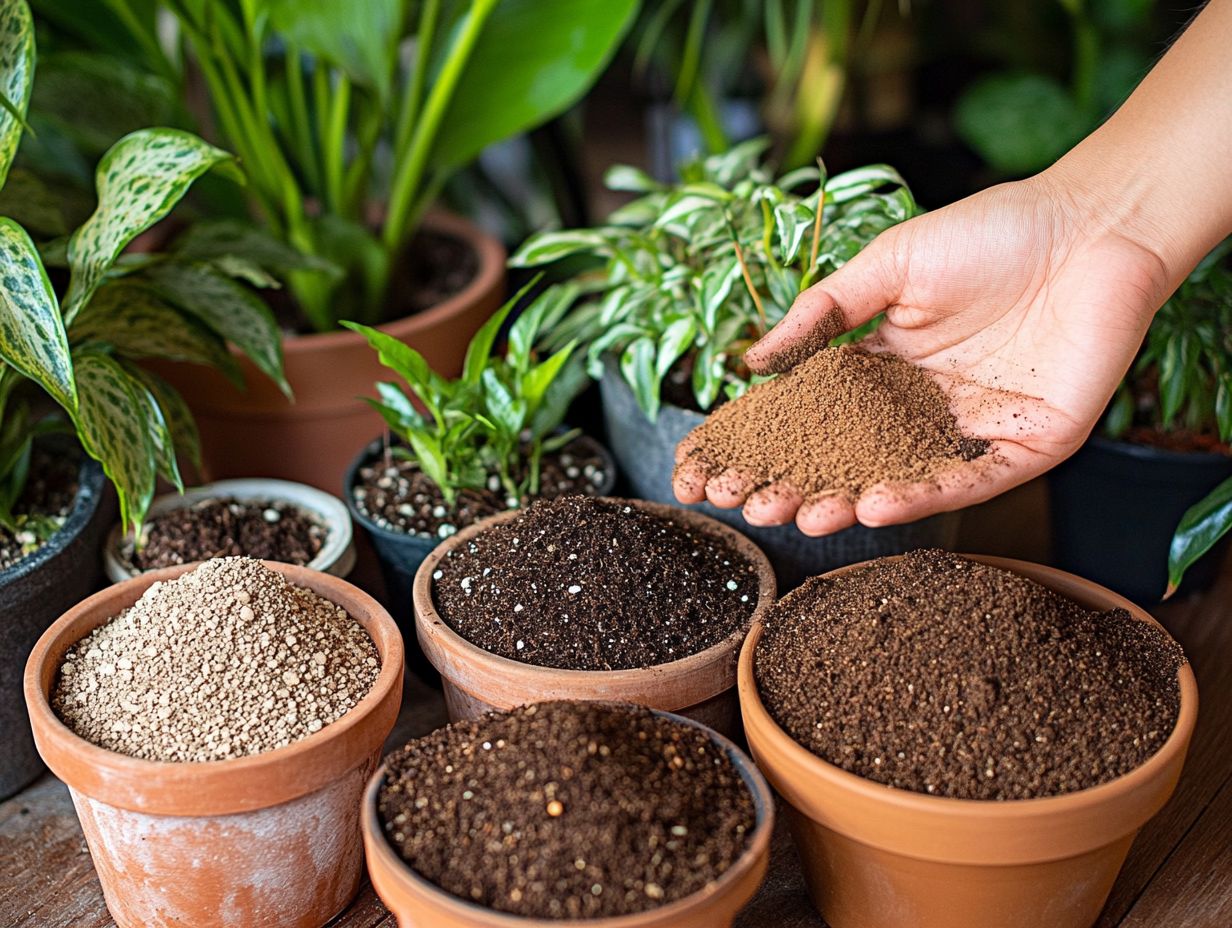
Let s dive into how you can nourish and protect your plant’s soil! Consider integrating specific amendments like peat moss and practices that foster healthy roots and enhance moisture retention.
Incorporating organic materials like compost, peat moss, coco coir, or worm castings can significantly improve your soil’s structure. This provides vital nutrients while boosting its ability to hold moisture. For better moisture retention, consider learning how to maintain soil moisture for indoor plants. You might also want to add materials such as perlite or vermiculite, which enhance drainage and aeration. This ensures your roots receive the oxygen they need and prevents conditions that lead to root rot. Don’t wait! Regularly check your pH levels with a simple test kit to keep your plants thriving!
Utilizing quality gardening supplies, like moisture meters and organic fertilizers, will help you maintain the perfect environment. For more detailed insight, check out this guide on how to maintain soil health for indoor plants. This sets the stage for thriving plants with robust growth and vibrant foliage.
Common Mistakes to Avoid with Indoor Plant Soil
Steering clear of common pitfalls with indoor plant soil can significantly enhance the health and longevity of your beloved greenery. This is especially true when considering proper soil types and watering preferences. By paying attention to the right soil composition, including soil amendments and moisture levels, you can create an ideal environment that allows your indoor plants to thrive and flourish.
Start creating the best soil environment for your indoor plants today by understanding soil pH for indoor plants!
Issues to Watch Out for
When caring for indoor plants, several issues can emerge, especially about root rot, soil density, and the choice of drainage materials such as charcoal rocks or sand. These factors can profoundly affect the overall health of your plants, potentially leading to stunted growth, wilting leaves, and, in the worst-case scenario, they can even kill your plants if not properly managed.
Root rot, for example, typically arises from overwatering and inadequate drainage, causing roots to become mushy and discolored. Soil density affects how well air moves through the soil, hindering roots from effectively absorbing the essential nutrients and water they need. Understanding the role of soil in indoor plant ecosystems can help prevent using inappropriate drainage materials that can lead to waterlogged conditions, compounding these risks.
To solve these problems, use potting mixes that drain well and houseplant mix, ensure your pots have adequate drainage holes, and establish a regular watering plan that caters to the unique requirements of each plant variety.
Frequently Asked Questions
What should I look for when trying to find the right soil for my indoor plants?
When searching for the perfect soil for your indoor plants, including plants that grow on other plants and tropical plants, there are a few key things to keep in mind. Look for a soil that is well-draining, nutrient-rich, and has a good balance of organic matter, like coco coir or peat moss.
Can I use regular garden soil for my indoor plants?
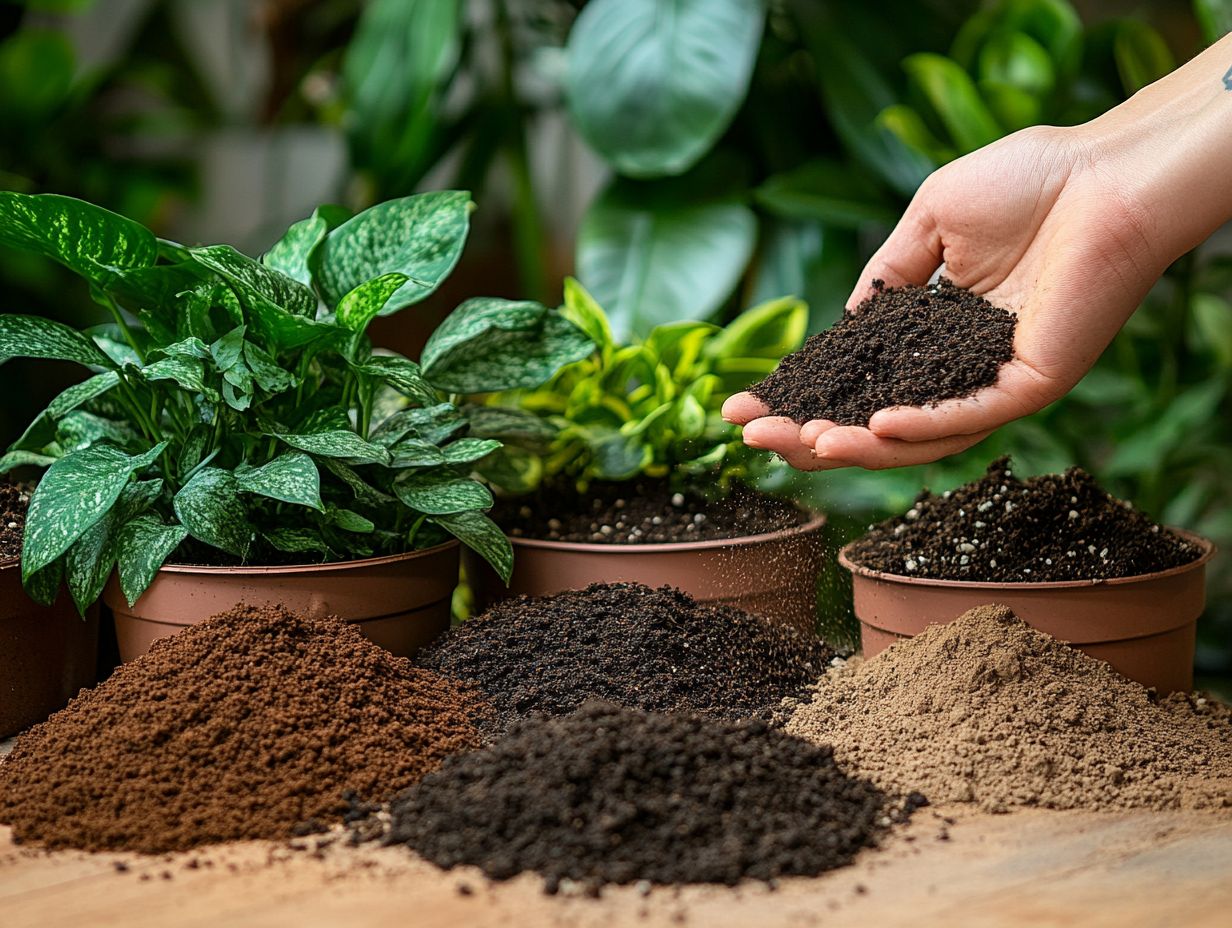
No, regular garden soil is not suitable for indoor plants. It is too heavy and does not provide proper drainage, which can lead to root rot. It can even harbor pests and diseases that threaten your plants!
What type of soil mix is best for succulents and cacti?
Succulents and cacti thrive in a well-draining soil mix. Look for a soil specifically designed for these types of plants, or make your own by mixing equal parts potting soil, coarse sand, and perlite.
How can I tell if my indoor plants need to be repotted with new soil?
If your plants are not thriving, it may be a sign that they need to be repotted with fresh soil. You can also check for cramped roots by gently removing them from their pot and inspecting the roots. If they are tightly packed and circling the bottom of the pot, it’s time for new soil.
Are there any alternative soil options for my indoor plants?
Yes, there are some alternative soil options for indoor plants such as coco coir, peat moss, and vermiculite. These can be used alone or mixed with traditional potting soil to provide extra nutrients and moisture retention.
Is it necessary to add fertilizer to my indoor plant’s soil?
Fertilizer helps indoor plants. But it’s not always needed. If you are using a high-quality potting soil, it may already have enough nutrients for your plants. However, if your plants show signs of nutrient deficiency, adding a slow-release fertilizer can help.
Start checking your plants today to ensure they are getting the care they need!

